 With the temperature dropping, it's time to find someone to keep you warm. Find your hookups with our online dating guide!
With the temperature dropping, it's time to find someone to keep you warm. Find your hookups with our online dating guide!

Music Home / Entertainment Channel / Bullz-Eye Home
 Please Kill Me: The Uncensored Oral History of Punk, by Legs McNeil and Gillian McCain
Please Kill Me: The Uncensored Oral History of Punk, by Legs McNeil and Gillian McCain
 If you’re seeking an authoritative look at punk as a subculture, you could hardly ask for a more appropriate guide than Roderick “Legs” McNeil, the co-founder of “Punk” magazine. Setting aside the heavy irony implicit in the publication of an oral history by a guy whose stated goal in starting said magazine was to “get free drinks,” “Please Kill Me” is a delightfully scuzzy look back at the birth of punk (a genre McNeil claims to have named, by the way). It’s heavy on the sort of salacious details – who was sleeping with whom, which drugs were being taken – that casual readers will love. McNeil’s focus is actually puzzlingly non-musical; rather than looking at the songs, he emphasizes all the crazy, self-destructive behavior that was taking place offstage, which is certainly entertaining, but may very well be a source of irritation for hardcore fans. Still, you could hardly expect otherwise from the man who walked away from “Punk”after four years because he felt the scene was too mainstream; for him, punk was always just as much about the lifestyle as it was the music. You may disagree, but you’ll still find “Please Kill Me”tough to put down.
If you’re seeking an authoritative look at punk as a subculture, you could hardly ask for a more appropriate guide than Roderick “Legs” McNeil, the co-founder of “Punk” magazine. Setting aside the heavy irony implicit in the publication of an oral history by a guy whose stated goal in starting said magazine was to “get free drinks,” “Please Kill Me” is a delightfully scuzzy look back at the birth of punk (a genre McNeil claims to have named, by the way). It’s heavy on the sort of salacious details – who was sleeping with whom, which drugs were being taken – that casual readers will love. McNeil’s focus is actually puzzlingly non-musical; rather than looking at the songs, he emphasizes all the crazy, self-destructive behavior that was taking place offstage, which is certainly entertaining, but may very well be a source of irritation for hardcore fans. Still, you could hardly expect otherwise from the man who walked away from “Punk”after four years because he felt the scene was too mainstream; for him, punk was always just as much about the lifestyle as it was the music. You may disagree, but you’ll still find “Please Kill Me”tough to put down.
– Jeff Giles
 Psychotic Reactions and Carburetor Dung, by Lester Bangs, edited by Greil Marcus
Psychotic Reactions and Carburetor Dung, by Lester Bangs, edited by Greil Marcus
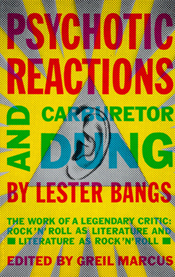 In the same way that listening to John McLaughlin can make an aspiring guitarist want to put down his guitar forever, reading the reviews, interviews and essays of legendary rock critic Lester Bangs (“Rolling Stone,” “Creem,” the “Village Voice”) can make the aspiring music writer want to toss his computer out of a high rise building. Bangs’ passion and knowledge were so artfully intertwined that another legendary critic, Greil Marcus, was driven to express in his introduction to “Psychotic Reactions and Carburetor Dung” his agreement with Bangs himself that the man was the best writer in America. One could easily take this with a grain of salt, given that Bangs and Marcus were good friends, and Marcus himself qualifies his stance by suggesting that his compilation of Bangs’ writings “demands from the reader ... a willingness to accept that the best writer in America could write almost nothing but record reviews.” For the reader who can make that leap, the rewards are many. Bangs approached his craft with the fearlessness and reckless abandon that typified the raucous rock n’ roll he loved. The argument between Bangs and Lou Reed in ’75 on Reed’s “decadent” influence in rock was a great example: Bangs: “Okay, let’s define decadence. You tell me what you think is decadence.” Reed: “You. Because you used to be able to write and now you’re just full of shit.” If rock n’ roll wasn’t ever meant to be read, Bangs changed that idea for good.
In the same way that listening to John McLaughlin can make an aspiring guitarist want to put down his guitar forever, reading the reviews, interviews and essays of legendary rock critic Lester Bangs (“Rolling Stone,” “Creem,” the “Village Voice”) can make the aspiring music writer want to toss his computer out of a high rise building. Bangs’ passion and knowledge were so artfully intertwined that another legendary critic, Greil Marcus, was driven to express in his introduction to “Psychotic Reactions and Carburetor Dung” his agreement with Bangs himself that the man was the best writer in America. One could easily take this with a grain of salt, given that Bangs and Marcus were good friends, and Marcus himself qualifies his stance by suggesting that his compilation of Bangs’ writings “demands from the reader ... a willingness to accept that the best writer in America could write almost nothing but record reviews.” For the reader who can make that leap, the rewards are many. Bangs approached his craft with the fearlessness and reckless abandon that typified the raucous rock n’ roll he loved. The argument between Bangs and Lou Reed in ’75 on Reed’s “decadent” influence in rock was a great example: Bangs: “Okay, let’s define decadence. You tell me what you think is decadence.” Reed: “You. Because you used to be able to write and now you’re just full of shit.” If rock n’ roll wasn’t ever meant to be read, Bangs changed that idea for good.
– Michael Fortes
 The Real Frank Zappa Book, by Frank Zappa
The Real Frank Zappa Book, by Frank Zappa
 If you want the facts, go to the source, right? Frank Zappa has been the subject of a few biographies, but none of them are as funny or as entertaining as this one that he penned himself. In it, he dissects all the stupid and raunchy myths that surrounded him during the years of the Mothers, his undying work ethic that allowed him to always be true to himself and to the people who “got it” (labels and conglomerates be damned), and how to have a successful family life. Throughout, Zappa is good-natured and honest; one can instantly sense the absolute genius that enveloped the man. He never tired of creating his art, and would undoubtedly still be doing just that were he still around these days. Luckily, wife Gail and the Zappa Family Trust still keep unearthing previously unreleased treasures for all the fans. The portion of the book regarding the infamous PMRC (Parents Music Resource Center) hearings and censorship in general is eye-opening for any music fan, as are Zappa’s countless other ideas of the music industry, which he touches on throughout the book. Certainly essential for any Frankophile, as well as for music fans who want to know about the seedy underside to the biz in general.
If you want the facts, go to the source, right? Frank Zappa has been the subject of a few biographies, but none of them are as funny or as entertaining as this one that he penned himself. In it, he dissects all the stupid and raunchy myths that surrounded him during the years of the Mothers, his undying work ethic that allowed him to always be true to himself and to the people who “got it” (labels and conglomerates be damned), and how to have a successful family life. Throughout, Zappa is good-natured and honest; one can instantly sense the absolute genius that enveloped the man. He never tired of creating his art, and would undoubtedly still be doing just that were he still around these days. Luckily, wife Gail and the Zappa Family Trust still keep unearthing previously unreleased treasures for all the fans. The portion of the book regarding the infamous PMRC (Parents Music Resource Center) hearings and censorship in general is eye-opening for any music fan, as are Zappa’s countless other ideas of the music industry, which he touches on throughout the book. Certainly essential for any Frankophile, as well as for music fans who want to know about the seedy underside to the biz in general.
– Jason Thompson
 Redemption Song: The Ballad of Joe Strummer, by Chris Salewicz
Redemption Song: The Ballad of Joe Strummer, by Chris Salewicz
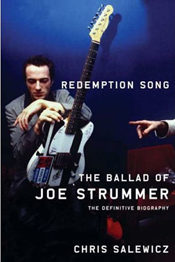 Joe Strummer read a couple of biographies of Montgomery Clift and later said, "If you read [more than one], you get a totally different angle, and you think, ‘Was he like this, or like that?’ And you realize he was probably like neither." It's hard to imagine that there is an angle to Strummer that hasn't been covered in Chris Salewicz's biography of the man; it's just so damn complete, covering practically every minute of Strummer's fifty years on the planet while detailing his influences and how he influenced others. It seems that Salewicz has talked to every single person still alive who knew, worked with, or even sold groceries to Joe Strummer (see, we said it was complete), but it also wasn’t as hard for Salewicz to do as you’d think. He was intimately involved in Strummer's personal and professional career, and as a result, there doesn't seem to be a dishonest word in here, but despite his closeness to the subject, this is still a very balanced record of Joe Strummer. Salewicz reports that Strummer was an obsessive fan of the Andalusian poet, dramatist and victim of the Spanish Civil War Federico Garcia Lorca, and has found a quote of his that sums up, in the author's view, the driving force of Strummer's creativity: “At the heart of all great art is an essential melancholy.” It’s sad but true, and Salewicz provides the proof.
Joe Strummer read a couple of biographies of Montgomery Clift and later said, "If you read [more than one], you get a totally different angle, and you think, ‘Was he like this, or like that?’ And you realize he was probably like neither." It's hard to imagine that there is an angle to Strummer that hasn't been covered in Chris Salewicz's biography of the man; it's just so damn complete, covering practically every minute of Strummer's fifty years on the planet while detailing his influences and how he influenced others. It seems that Salewicz has talked to every single person still alive who knew, worked with, or even sold groceries to Joe Strummer (see, we said it was complete), but it also wasn’t as hard for Salewicz to do as you’d think. He was intimately involved in Strummer's personal and professional career, and as a result, there doesn't seem to be a dishonest word in here, but despite his closeness to the subject, this is still a very balanced record of Joe Strummer. Salewicz reports that Strummer was an obsessive fan of the Andalusian poet, dramatist and victim of the Spanish Civil War Federico Garcia Lorca, and has found a quote of his that sums up, in the author's view, the driving force of Strummer's creativity: “At the heart of all great art is an essential melancholy.” It’s sad but true, and Salewicz provides the proof.
– Mike Connolly
 Rip It Up and Start Again: Postpunk 1978-1984, by Simon Reynolds
Rip It Up and Start Again: Postpunk 1978-1984, by Simon Reynolds
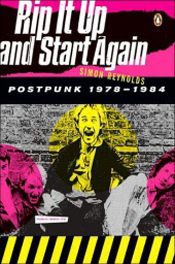 The six years covered in Simon Reynolds’ impressive retrospective will never have the easy media-readiness of either the punk era or the ‘60s, but the author’s claim that the postpunk era “rivals the sixties as a golden age for music” is more than backed up by this excellent tome. Starting with PiL and ending with Frankie Goes to Hollywood and the Art of Noise, the chapters follow a roughly chronological order, and groups bands geographically and/or stylistically. So you get chapters on Buzzcocks, Magazine and Subway Sect, for instance, as well as Cleveland (Pere Ubu, Devo), Manchester, (The Fall, Joy Division), NYC (“no wave”), Leeds (Gang of Four, The Mekons), Sheffield (Cabaret Voltaire, The Human League), to name a few. Reynolds also covers industrial/goth, 2-Tone/ska, synthpop, Scottish pop, punk-funk/mutant disco, new psychedelia, independent labels and more. It’s quite an accomplishment, and you’ll come away believing that the postpunk era was when punk’s original objectives (to do away with the veneration and clichés that had come to dominate rock/pop music) were actually realized. – Una Persson
The six years covered in Simon Reynolds’ impressive retrospective will never have the easy media-readiness of either the punk era or the ‘60s, but the author’s claim that the postpunk era “rivals the sixties as a golden age for music” is more than backed up by this excellent tome. Starting with PiL and ending with Frankie Goes to Hollywood and the Art of Noise, the chapters follow a roughly chronological order, and groups bands geographically and/or stylistically. So you get chapters on Buzzcocks, Magazine and Subway Sect, for instance, as well as Cleveland (Pere Ubu, Devo), Manchester, (The Fall, Joy Division), NYC (“no wave”), Leeds (Gang of Four, The Mekons), Sheffield (Cabaret Voltaire, The Human League), to name a few. Reynolds also covers industrial/goth, 2-Tone/ska, synthpop, Scottish pop, punk-funk/mutant disco, new psychedelia, independent labels and more. It’s quite an accomplishment, and you’ll come away believing that the postpunk era was when punk’s original objectives (to do away with the veneration and clichés that had come to dominate rock/pop music) were actually realized. – Una Persson
 The Rose and the Briar: Death, Love and Liberty in the American Ballad, by Greil Marcus and Sean Wilentz
The Rose and the Briar: Death, Love and Liberty in the American Ballad, by Greil Marcus and Sean Wilentz
 Twenty-two writers each pick an American ballad (defined primarily as a song with narrative content, and not necessarily old-world folk songs) and elaborate on it, with some remarkable results and amazing insight. The writers were asked by coeditors Greil Marcus (“Lipstick Traces,” “The Old, Weird America,”) and Sean Wilentz (Princeton history prof), to “help create some new works of art” of ballads of their own choosing, and the results are expectedly diverse. Novelists Joyce Carol Oates and Sharon McCrumb turn in works of fiction, for instance, while artists R. Crumb and Jon Langford respond with cartoons. Other contributors include Dave Marsh on “Barbara Allen,” Cecil Brown on “Frankie and Albert;” Pere Ubu’s David Thomas on both “The Wreck of Old 97” (about a train wreck in the early 1900s) and “Dead Man’s Curve” (the 1964 hit by Jan & Dean about a car crash); Wendy Lesser on dancing with her newborn to Dylan’s “Lily, Rosemary and the Jack of Hearts;” and Howard Hampton on Springsteen’s “Nebraska” among other delights and surprises. Marcus’ notes and essays are always a delight, and the companion CD only helps shed more light on this unique take on an integral part of American culture. – Una Persson
Twenty-two writers each pick an American ballad (defined primarily as a song with narrative content, and not necessarily old-world folk songs) and elaborate on it, with some remarkable results and amazing insight. The writers were asked by coeditors Greil Marcus (“Lipstick Traces,” “The Old, Weird America,”) and Sean Wilentz (Princeton history prof), to “help create some new works of art” of ballads of their own choosing, and the results are expectedly diverse. Novelists Joyce Carol Oates and Sharon McCrumb turn in works of fiction, for instance, while artists R. Crumb and Jon Langford respond with cartoons. Other contributors include Dave Marsh on “Barbara Allen,” Cecil Brown on “Frankie and Albert;” Pere Ubu’s David Thomas on both “The Wreck of Old 97” (about a train wreck in the early 1900s) and “Dead Man’s Curve” (the 1964 hit by Jan & Dean about a car crash); Wendy Lesser on dancing with her newborn to Dylan’s “Lily, Rosemary and the Jack of Hearts;” and Howard Hampton on Springsteen’s “Nebraska” among other delights and surprises. Marcus’ notes and essays are always a delight, and the companion CD only helps shed more light on this unique take on an integral part of American culture. – Una Persson
 Rotten: No Irish, No Blacks, No Dogs, by John Lydon
Rotten: No Irish, No Blacks, No Dogs, by John Lydon
 Perhaps the greatest accomplishment of this memoir of The Man Who Would Be Rotten is that he allows other people to get a word in edgewise. No one’s ever accused John Lydon of being a shy, quiet bloke, and his autobiography didn’t change that perception in the slightest. But he allows his personal history of the Sex Pistols and the beginnings of punk rock in the U.K. to be interspersed with comments from other participants who offer varying levels of agreement to his version of the events. “All the people in this book were actually there, and this book is as much their point of view as it is mine,” he clarifies in the introduction. “This means contradictions and insults have not been edited.” Former bandmates Steve Jones and Paul Cook chime in, as do some of Lydon’s punk peers, including Chrissie Hynde, Billy Idol, Marco Pirroni (Adam & The Ants), Steve Steverin (Siouxsie & The Banshees), and Dave Ruffy (The Ruts). The history of the Pistols themselves, however, has been so thoroughly documented that it’s the description of Lydon’s childhood that proves the most enlightening. Who would’ve believed that Johnny was a bit of a mama’s boy? Additionally, the discussions of Sid Vicious reveal the depths of their friendship and offer considerable clarification as to why Lydon hated “Sid and Nancy” as much as he did. Even with the additional viewpoints, “Rotten” isn’t exactly an unbiased look at the history of the Pistols – Lydon’s far too close to the subject for that – but at the very least, you won’t get the feeling you’ve been cheated after you’ve read it. – Will Harris
Perhaps the greatest accomplishment of this memoir of The Man Who Would Be Rotten is that he allows other people to get a word in edgewise. No one’s ever accused John Lydon of being a shy, quiet bloke, and his autobiography didn’t change that perception in the slightest. But he allows his personal history of the Sex Pistols and the beginnings of punk rock in the U.K. to be interspersed with comments from other participants who offer varying levels of agreement to his version of the events. “All the people in this book were actually there, and this book is as much their point of view as it is mine,” he clarifies in the introduction. “This means contradictions and insults have not been edited.” Former bandmates Steve Jones and Paul Cook chime in, as do some of Lydon’s punk peers, including Chrissie Hynde, Billy Idol, Marco Pirroni (Adam & The Ants), Steve Steverin (Siouxsie & The Banshees), and Dave Ruffy (The Ruts). The history of the Pistols themselves, however, has been so thoroughly documented that it’s the description of Lydon’s childhood that proves the most enlightening. Who would’ve believed that Johnny was a bit of a mama’s boy? Additionally, the discussions of Sid Vicious reveal the depths of their friendship and offer considerable clarification as to why Lydon hated “Sid and Nancy” as much as he did. Even with the additional viewpoints, “Rotten” isn’t exactly an unbiased look at the history of the Pistols – Lydon’s far too close to the subject for that – but at the very least, you won’t get the feeling you’ve been cheated after you’ve read it. – Will Harris
 Shake Some Action: The Ultimate Power Pop Guide, by John Borack
Shake Some Action: The Ultimate Power Pop Guide, by John Borack
 It’s a hard life for the power pop fan – let that music get under your skin, and you’re condemning yourself to a life of flipping through dusty stacks of used CDs (or LPs), trolling Internet fan communities whose denizens hotly debate the merits of bands with names like the Greenberry Woods and the Wondermints, paying astronomical prices for Japanese imports, and mourning, at least once a decade, the ignominious demise of a label foolish enough to dedicate itself to spreading the power pop love. (Rest in peace, Big Deal Records.) But if you’re foolish enough to ignore all these warnings and insist on flooding your ears with the infectious works of bands who wish the early ‘70s never ended, John Borack’s “Shake Some Action”is the perfect guidebook to get you started. Start saving your pennies now, because reading this book – and listening to the accompanying CD, packed with rare and unreleased gems from some of the leading lights of power pop – is likely to send you into a music-buying frenzy from which your checking account won’t soon recover. – Jeff Giles
It’s a hard life for the power pop fan – let that music get under your skin, and you’re condemning yourself to a life of flipping through dusty stacks of used CDs (or LPs), trolling Internet fan communities whose denizens hotly debate the merits of bands with names like the Greenberry Woods and the Wondermints, paying astronomical prices for Japanese imports, and mourning, at least once a decade, the ignominious demise of a label foolish enough to dedicate itself to spreading the power pop love. (Rest in peace, Big Deal Records.) But if you’re foolish enough to ignore all these warnings and insist on flooding your ears with the infectious works of bands who wish the early ‘70s never ended, John Borack’s “Shake Some Action”is the perfect guidebook to get you started. Start saving your pennies now, because reading this book – and listening to the accompanying CD, packed with rare and unreleased gems from some of the leading lights of power pop – is likely to send you into a music-buying frenzy from which your checking account won’t soon recover. – Jeff Giles
 So You Wanna Be A Rock ‘n’ Roll Star, by Jacob Slichter / Everything I’m Cracked Up To Be, by Jen Trynin (TIE)
So You Wanna Be A Rock ‘n’ Roll Star, by Jacob Slichter / Everything I’m Cracked Up To Be, by Jen Trynin (TIE)
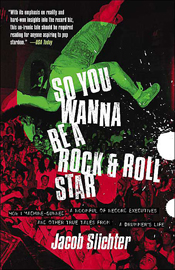 It’s no secret that the music industry chews up and spits out way more artists than it ever raises to fortune and fame, but once you finally grab that brass ring and sign to a major label, it’s nothing but hookers, blow, cash, and unlimited creative control, right? Uh, not quite, as Jen Trynin reveals in “Everything I’m Cracked Up To Be.” Trynin was enjoying the hometown crowds when she was swept off her feet by a label determined to make her a star. Unfortunately, she didn’t take to the change-this/fix-that mentality, and just as she was finally starting to tolerate the situation, the label decided to shift its allegiance – and, more importantly, its budget – over to one A. Morisette. (Because, as we know, a label can’t possibly focus on more than one powerful female singer-songwriter at a time.) Meanwhile, over in “So You Wanna Be A Rock ‘n’ Roll Star,” former Semisonic drummer Jacob Slichter confirms that you can hit the highest heights and still be yesterday’s news in a heartbeat. These books are arguably two different sides of the same coin, with both Trynin and Slichter going through similar situations and having to put up with the hassle of the same backstage shenanigans. Each has its own unique spin on the story, however, with Trynin’s interpersonal relationships playing as much of a part in her tale as her music. Slichter, meanwhile, earns a greater amount of commercial success, but the end result only finds him having farther to fall. Is it any wonder artists are taking to releasing their own records these days? – Will Harris
It’s no secret that the music industry chews up and spits out way more artists than it ever raises to fortune and fame, but once you finally grab that brass ring and sign to a major label, it’s nothing but hookers, blow, cash, and unlimited creative control, right? Uh, not quite, as Jen Trynin reveals in “Everything I’m Cracked Up To Be.” Trynin was enjoying the hometown crowds when she was swept off her feet by a label determined to make her a star. Unfortunately, she didn’t take to the change-this/fix-that mentality, and just as she was finally starting to tolerate the situation, the label decided to shift its allegiance – and, more importantly, its budget – over to one A. Morisette. (Because, as we know, a label can’t possibly focus on more than one powerful female singer-songwriter at a time.) Meanwhile, over in “So You Wanna Be A Rock ‘n’ Roll Star,” former Semisonic drummer Jacob Slichter confirms that you can hit the highest heights and still be yesterday’s news in a heartbeat. These books are arguably two different sides of the same coin, with both Trynin and Slichter going through similar situations and having to put up with the hassle of the same backstage shenanigans. Each has its own unique spin on the story, however, with Trynin’s interpersonal relationships playing as much of a part in her tale as her music. Slichter, meanwhile, earns a greater amount of commercial success, but the end result only finds him having farther to fall. Is it any wonder artists are taking to releasing their own records these days? – Will Harris
 Songbook, by Nick Hornby
Songbook, by Nick Hornby
 We all have made our own personal compilation or “mix” (to submit to the more popular vernacular) tapes (or CDs or iTunes playlists). You may have even written some short “liner notes” on each song for some of your mates on a few of those collections. Well, when you’ve got the intense passion for music and the writing chops of a Nick Hornby (author of the great music-themed book-turned-movie “High Fidelity”), those notes can quickly become a series of short essays, which in turn can add up to a small book. And that’s exactly what “Songbook” is – a collection of witty, entertaining essays on 31 of Hornby’s favorite songs of all time, some of which you may know and some you’ve probably never heard in your life. So why should we care? Fortunately, Hornby tempers the common tendency to assign too much importance to associative memories when writing about his favorite songs, so that the songs are the stars of the show, using his memories as the supporting cast to cheer them on. His arguably snobby comment in his intro that “the people who say their very favorite record of all time reminds them of their honeymoon in Corsica, or of their family Chihuahua, don’t actually like music very much” defines the audience for this book from the outset. Bottom line: if you love music and love to be entertained when you read, you’ll really dig “Songbook.” And you might be turned on to some new tunes along the way. – Michael Fortes
We all have made our own personal compilation or “mix” (to submit to the more popular vernacular) tapes (or CDs or iTunes playlists). You may have even written some short “liner notes” on each song for some of your mates on a few of those collections. Well, when you’ve got the intense passion for music and the writing chops of a Nick Hornby (author of the great music-themed book-turned-movie “High Fidelity”), those notes can quickly become a series of short essays, which in turn can add up to a small book. And that’s exactly what “Songbook” is – a collection of witty, entertaining essays on 31 of Hornby’s favorite songs of all time, some of which you may know and some you’ve probably never heard in your life. So why should we care? Fortunately, Hornby tempers the common tendency to assign too much importance to associative memories when writing about his favorite songs, so that the songs are the stars of the show, using his memories as the supporting cast to cheer them on. His arguably snobby comment in his intro that “the people who say their very favorite record of all time reminds them of their honeymoon in Corsica, or of their family Chihuahua, don’t actually like music very much” defines the audience for this book from the outset. Bottom line: if you love music and love to be entertained when you read, you’ll really dig “Songbook.” And you might be turned on to some new tunes along the way. – Michael Fortes
 Songwriters on Songwriting, by Paul Zollo
Songwriters on Songwriting, by Paul Zollo
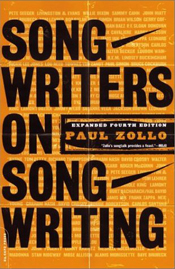 Plenty of books have been written about the songwriting process; some of them (Jimmy Webb’s “Tunesmith”comes to mind) are even rightly considered classics of the genre. For sheer bang for your buck, however, you can't beat Paul Zollo's four-times-expanded “Songwriters on Songwriting,” which collects dozens of interviews with some of the most successful and influential artists in rock history. Zollo is a songwriter himself – he fronted the Ghosters and embarked on a brief solo career in the '90s – so he understands the process, which is part of why he’s so good at getting these performers to talk about what makes them tick. He’s lined up an admirably diverse group here, too – the latest edition features everyone from Pete Seeger, Willie Dixon, and Sammy Cahn to Madonna, Bruce Hornsby, and the members of R.E.M. In terms of perspective, it’s heavily rockist, but even if he’s guilty of concentrating on one flavor of music, Zollo does an outstanding job of distilling its essential ingredients. – Jeff Giles
Plenty of books have been written about the songwriting process; some of them (Jimmy Webb’s “Tunesmith”comes to mind) are even rightly considered classics of the genre. For sheer bang for your buck, however, you can't beat Paul Zollo's four-times-expanded “Songwriters on Songwriting,” which collects dozens of interviews with some of the most successful and influential artists in rock history. Zollo is a songwriter himself – he fronted the Ghosters and embarked on a brief solo career in the '90s – so he understands the process, which is part of why he’s so good at getting these performers to talk about what makes them tick. He’s lined up an admirably diverse group here, too – the latest edition features everyone from Pete Seeger, Willie Dixon, and Sammy Cahn to Madonna, Bruce Hornsby, and the members of R.E.M. In terms of perspective, it’s heavily rockist, but even if he’s guilty of concentrating on one flavor of music, Zollo does an outstanding job of distilling its essential ingredients. – Jeff Giles
 Sound of the Beast: The Complete Headbanging History of Heavy Metal, by Ian Christe
Sound of the Beast: The Complete Headbanging History of Heavy Metal, by Ian Christe
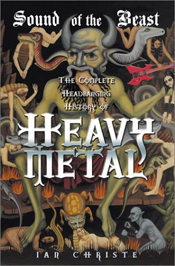 This dense and encyclopedic tome charts the full history of heavy metal, and author Ian Christe, far from simply chronicling the biographies and output of the bands that make up this history, extols both metal’s virtues and its ironies, its antiestablishment DNA and the hypocrisy of the anti-metal conservative establishment. While he does dwell overlong on Metallica – which dominates the middle of the book, as Christe builds a well-founded case for Ulrich, Hetfield & Co. being the high water mark of metal – this book is not an ad nauseum dwelling on hard rock’s household names. Beginning with the birth of metal via Black Sabbath, Judas Priest and Iron Maiden, Christe follows all of the highways and byways of the genre, through present-day practitioner’s of nu metal, and ends up almost back where he started, with a reformed, reunited (and sober) Black Sabbath. Along the way, Christe digs his critical teeth into protometal (UFO), NWOBHM (Raven), power metal (Anvil), German speed metal (Coroner), grindcore (Bolt Thrower), alternative metal (Kyuss), death metal (Cannibal Corpse), and more. He also touches on underground metal tape-trading, dives deeply into the dark and murky waters of Norwegian black metal (whose practitioners, in some extreme cases, practice what they preach), anti-metal lawsuits, social criticism and so on, in an engaging, enthusiastic, knowing and, at times, humorous writing style. To his credit, he focuses as much on lesser known bands (Napalm Death, Nuclear Assault), offers up plenty of quotes from the players themselves, and folds in the interesting minutia throughout. Like the music it covers, “Sound of the Beast” can be a little dense at times, but the subtitle of the book claims it to be the “complete” history, after all.
This dense and encyclopedic tome charts the full history of heavy metal, and author Ian Christe, far from simply chronicling the biographies and output of the bands that make up this history, extols both metal’s virtues and its ironies, its antiestablishment DNA and the hypocrisy of the anti-metal conservative establishment. While he does dwell overlong on Metallica – which dominates the middle of the book, as Christe builds a well-founded case for Ulrich, Hetfield & Co. being the high water mark of metal – this book is not an ad nauseum dwelling on hard rock’s household names. Beginning with the birth of metal via Black Sabbath, Judas Priest and Iron Maiden, Christe follows all of the highways and byways of the genre, through present-day practitioner’s of nu metal, and ends up almost back where he started, with a reformed, reunited (and sober) Black Sabbath. Along the way, Christe digs his critical teeth into protometal (UFO), NWOBHM (Raven), power metal (Anvil), German speed metal (Coroner), grindcore (Bolt Thrower), alternative metal (Kyuss), death metal (Cannibal Corpse), and more. He also touches on underground metal tape-trading, dives deeply into the dark and murky waters of Norwegian black metal (whose practitioners, in some extreme cases, practice what they preach), anti-metal lawsuits, social criticism and so on, in an engaging, enthusiastic, knowing and, at times, humorous writing style. To his credit, he focuses as much on lesser known bands (Napalm Death, Nuclear Assault), offers up plenty of quotes from the players themselves, and folds in the interesting minutia throughout. Like the music it covers, “Sound of the Beast” can be a little dense at times, but the subtitle of the book claims it to be the “complete” history, after all.
– Una Persson
 Trouser Press Record Guide, edited by Ira Robbins
Trouser Press Record Guide, edited by Ira Robbins
When I was in high school, my friend Warno subscribe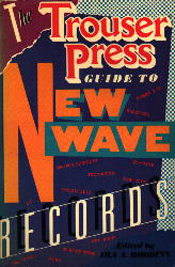 d to a NYC-based magazine called “Trouser Press” that covered the British punk and new wave music scene. Every month, we’d read these fascinating tales of bands with strange names like The Jam, The Damned and The Clash that we never thought we’d hear. It was a wonderful magazine, and Ira Robbins and his staff get sole credit for exposing me to a brand new world of music. Fast-forward about 10 years: the magazine had stopped publishing, and there weren’t yet websites where one could learn about foreign bands not getting mentioned in the U.S. press or receiving airplay. I was in a used book store when I stumbled upon several different editions of “The Trouser Press Record Guide.” I immediately bought a copy of the 4th edition and read it cover to cover, finding a nearly comprehensive roster of each punk, new wave, rap and funk band that released an LP from the mid-‘70s on. (There are a few entries covering even older releases, and the few glaringly obvious omissions are explained by Robbins in the forward, which is also a must-read.) The 4th edition was released at the same time as Nirvana's Nevermind, and a whole new generation of music ensued but was not documented by Trouser Press. Robbins responded by compiling and releasing a brand new edition: “The Trouser Press Guide to ‘90s Rock.” It corrects, in Robbins’ words, “the irony that a project whose values were elementary to this upheaval was, in a marketing sense, left behind when the barricades were finally stormed.” A minimum of material is duplicated from earlier editions, and the reader is, where appropriate, directed to “See TPRG.” These two reference volumes are companion pieces that should sit side by side on every music writer’s desk, providing an excellent source for everything you ever wanted to know about the “alternative” music scene. Die-hard music fans should have these within arm’s reach as well, because you never know when your own peace of mind will require tracing out the connection between The Cars and Weezer. – Mike Connolly
d to a NYC-based magazine called “Trouser Press” that covered the British punk and new wave music scene. Every month, we’d read these fascinating tales of bands with strange names like The Jam, The Damned and The Clash that we never thought we’d hear. It was a wonderful magazine, and Ira Robbins and his staff get sole credit for exposing me to a brand new world of music. Fast-forward about 10 years: the magazine had stopped publishing, and there weren’t yet websites where one could learn about foreign bands not getting mentioned in the U.S. press or receiving airplay. I was in a used book store when I stumbled upon several different editions of “The Trouser Press Record Guide.” I immediately bought a copy of the 4th edition and read it cover to cover, finding a nearly comprehensive roster of each punk, new wave, rap and funk band that released an LP from the mid-‘70s on. (There are a few entries covering even older releases, and the few glaringly obvious omissions are explained by Robbins in the forward, which is also a must-read.) The 4th edition was released at the same time as Nirvana's Nevermind, and a whole new generation of music ensued but was not documented by Trouser Press. Robbins responded by compiling and releasing a brand new edition: “The Trouser Press Guide to ‘90s Rock.” It corrects, in Robbins’ words, “the irony that a project whose values were elementary to this upheaval was, in a marketing sense, left behind when the barricades were finally stormed.” A minimum of material is duplicated from earlier editions, and the reader is, where appropriate, directed to “See TPRG.” These two reference volumes are companion pieces that should sit side by side on every music writer’s desk, providing an excellent source for everything you ever wanted to know about the “alternative” music scene. Die-hard music fans should have these within arm’s reach as well, because you never know when your own peace of mind will require tracing out the connection between The Cars and Weezer. – Mike Connolly
 Wonderland Avenue: Tales of Glamour and Excess, by Danny Sugerman
Wonderland Avenue: Tales of Glamour and Excess, by Danny Sugerman
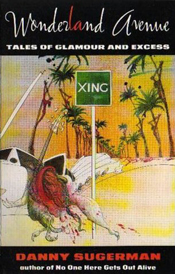 It’s been said that one screening of “Requiem for a Dream” is enough to put anyone off trying heroin, but “Wonderland Avenue” did the trick for a lot of readers back in 1989. Yes, Doors fans, Sugerman’s “No One Here Gets Out Alive” (co-written with Jerry Hopkins) was considered for this list, but the reason it didn’t make the final cut, frankly, is that Sugerman’s own story is a far more enthralling tale. Imagine a teenage kid who starts off working for The Doors and living large on the Sunset Strip, then, following the band’s break-up, gets involved with Ray Manzarek’s solo career before transitioning into a job as Iggy Pop’s manager. Nice work if you can get it, right? Naturally, the guy had to completely fuck it up by getting addicted to smack, but in his defense, when you’re working with Messrs. Morrison and Pop, substance abuse is practically a job requirement. It’s a rough read at times, mostly because you’ll repeatedly want to shake some sense into Sugerman, but there are also a surprising number of laughs, such as when he gets a phone call from a hysterical young debutante who shrieks that Iggy is “at the bottom of the driveway, chopping up Daddy’s Mercedes with the garden ax!” Although he had a rough relationship with his father and an even worse one with his stepdad, Sugerman makes no apologies for the many, many mistakes he made during the ‘60s and ‘70s, and the telling of his tale results in one of the most definitive tales of sex, drugs and rock ‘n’ roll ever written. – Will Harris
It’s been said that one screening of “Requiem for a Dream” is enough to put anyone off trying heroin, but “Wonderland Avenue” did the trick for a lot of readers back in 1989. Yes, Doors fans, Sugerman’s “No One Here Gets Out Alive” (co-written with Jerry Hopkins) was considered for this list, but the reason it didn’t make the final cut, frankly, is that Sugerman’s own story is a far more enthralling tale. Imagine a teenage kid who starts off working for The Doors and living large on the Sunset Strip, then, following the band’s break-up, gets involved with Ray Manzarek’s solo career before transitioning into a job as Iggy Pop’s manager. Nice work if you can get it, right? Naturally, the guy had to completely fuck it up by getting addicted to smack, but in his defense, when you’re working with Messrs. Morrison and Pop, substance abuse is practically a job requirement. It’s a rough read at times, mostly because you’ll repeatedly want to shake some sense into Sugerman, but there are also a surprising number of laughs, such as when he gets a phone call from a hysterical young debutante who shrieks that Iggy is “at the bottom of the driveway, chopping up Daddy’s Mercedes with the garden ax!” Although he had a rough relationship with his father and an even worse one with his stepdad, Sugerman makes no apologies for the many, many mistakes he made during the ‘60s and ‘70s, and the telling of his tale results in one of the most definitive tales of sex, drugs and rock ‘n’ roll ever written. – Will Harris
 The Worst Rock ‘n’ Roll Records of All Time: A Fan’s Guide to the Stuff You Love to Hate, by Jimmy Guterman and Owen O’Donnell
The Worst Rock ‘n’ Roll Records of All Time: A Fan’s Guide to the Stuff You Love to Hate, by Jimmy Guterman and Owen O’Donnell
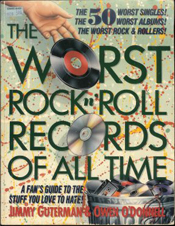 Any young punk with dreams of growing up to be a rock critic would do well to get his hands on a copy of this classic tome, which features page after side-splitting page of venomous snark directed at – well, the title says it all: the worst rock ‘n’ roll records of all time. Yes, there are some copouts here – novelty efforts from Irene Ryan (Granny on “The Beverly Hillbillies”) and Richard Simmons come to mind – but Guterman and O'Donnell also bring out the knives for a number of “real” artists, including Dylan, Jethro Tull, Mellencamp and Billy Joel. As a sharp kick to rock’s squishy underbelly, it’s splendidly entertaining – but as proof that nobody, not even St. Bob, is above making a shitty record or two, it’s also highly instructive. (And really, how can you go wrong with a book containing an essay about all of the many reasons why Emerson, Lake & Palmer’s Tarkus sucks?) Slaughter your sacred cows, future critics of America. Start here.
Any young punk with dreams of growing up to be a rock critic would do well to get his hands on a copy of this classic tome, which features page after side-splitting page of venomous snark directed at – well, the title says it all: the worst rock ‘n’ roll records of all time. Yes, there are some copouts here – novelty efforts from Irene Ryan (Granny on “The Beverly Hillbillies”) and Richard Simmons come to mind – but Guterman and O'Donnell also bring out the knives for a number of “real” artists, including Dylan, Jethro Tull, Mellencamp and Billy Joel. As a sharp kick to rock’s squishy underbelly, it’s splendidly entertaining – but as proof that nobody, not even St. Bob, is above making a shitty record or two, it’s also highly instructive. (And really, how can you go wrong with a book containing an essay about all of the many reasons why Emerson, Lake & Palmer’s Tarkus sucks?) Slaughter your sacred cows, future critics of America. Start here.
– Jeff Giles
You can follow us on Twitter and Facebook for content updates. Also, sign up for our email list for weekly updates and check us out on Google+ as well.










